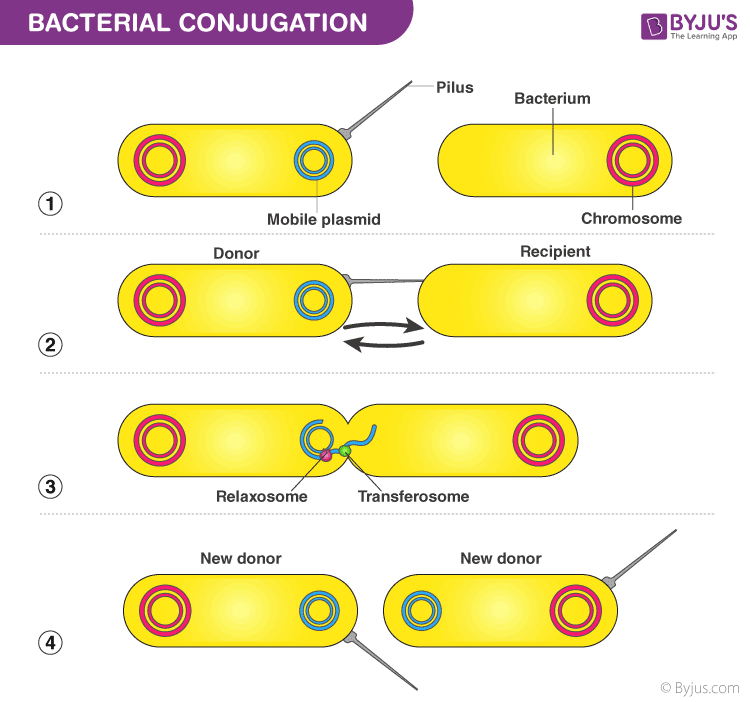Table of Contents
There are numerous bacteria found on planet earth. They divide quickly by binary fission producing identical daughter cells. Thus, the genetic information is transferred from the mother to the offspring and is known as vertical transmission.
The mutations are transferred from one bacteria to another through horizontal transmission. There are three different types of horizontal transmission for the transfer of genetic information.
- Conjugation
- Transduction
- Transformation
Bacterial Conjugation
Conjugation is the method of transfer of genetic material from one bacteria to another placed in contact. This method was proposed by Lederberg and Tatum. They discovered that the F-factor can move between E.coli cells and proposed the concept of conjugation.

There are various conjugal plasmids carried by various bacterial species. Conjugation is carried out in several steps:
- Mating pair formation
- Conjugal DNA synthesis
- DNA transfer
- Maturation
Also Read: R-Factor
Mechanism of Bacterial Conjugation
Bacterial conjugation involves the following steps:
Pilus Formation
The donor cells (F+ cells) form a sex pilus and begin contact with an F- recipient cell.
Physical Contact between Donor and Recipient Cell
The pilus forms a conjugation tube and enables direct contact between the donor and the recipient cells.
Transfer of F-Plasmid
The F-factor opens at the origin of replication. One strand is cut at the origin of replication, and the 5’ end enters the recipient cell.
Synthesis of Complementary Strand
The donor and the recipient strand both contain a single strand of the F-plasmid. Thus, a complementary strand is synthesized in both the recipient and the donor. The recipient cell now contains a copy of F plasmid and becomes a donor cell.
Also Read: Difference between Virus and Bacteria
Bacterial Transduction
Transduction is the process of transfer of genes from the recipient to the donor through bacteriophage.

Transduction is of two types:
- Generalized Transduction
- Specialized Transduction
Generalized Transduction
In this type, the bacteriophage first infects the donor cells and begins the lytic cycle. The virus then develops its components using the host cell machinery. The host cell DNA is hydrolyzed into small fragments by the viral enzymes.
Small pieces of bacteria DNA is now integrated into viral genome. When the virus infects another bacteria the DNA is transferred into it.
Specialized Transduction
In this, only a few restricted bacteria are transferred from donor to recipient bacteria. This is carried out by temperate bacteriophage which undergoes the lysogenic cycle.
The virus enters the bacteria and integrates its genome within the host cell DNA. It remains dormant and passes on from generation to generation. When the lysogenic cell is exposed to some external stimulus, the lytic cycle begins.
The viral genome is induced in the host cell genome. Due to this, the phage genome sometimes carries the bacterial genome with it and integrates it into the genome of the recipient cell. Here, only the restricted genome has the possibility of entering the recipient cells.
Bacterial Transformation
Transformation is the process of DNA uptake by the bacteria from the surrounding environment. The cells that have the ability to uptake DNA are known as competent cells. This process was first reported in Streptococcus pneumonia by Griffith.

Bacterial Competence
Not all bacteria are capable of taking up DNA from the surrounding environment. Such bacteria are made artificially competent. This is achieved by using chemicals and electrical pulses.
- Chemicals- The cells are chilled and made permeable in the presence of calcium phosphate. They are then incubated with the DNA and provided with a heat shock treatment that causes the DNA to enter the cells.
- Electroporation- The bacterial cells are subjected to electrical pulses to make them permeable and cause the DNA to enter into cells.
How to Identify Transformed Cells?
The bacteria are grown on an agar medium with antibiotics to check for transformed cells. Only the bacteria containing the antibiotic resistance gene will grow in the presence of antibiotics. The cells that survive and grow are transformed cells. The others are non-transformed.
Also Read: E.coli
For more information on bacterial genetics, bacterial conjugation, bacterial transduction, and bacterial transformation, keep visiting BYJU’S website or download BYJU’S app for further reference.
Frequently Asked Questions on
What are the three methods of genetic transfer in bacteria?
The three methods of genetic transfer in bacteria are conjugation, transduction and transformation.
What is bacterial genetic material?
The genetic material of bacteria is deoxy ribo nucleic acid or DNA. It is present as a single copy in circular form in the nucleoid region of bacteria.
What is plasmid DNA?
The extra chromosomal circular DNA present in bacteria is called plasmid. It codes for some genes like antibiotic resistance genes. During conjugation, a copy of plasmid is transferred to other bacteria. E.g: F-factor.
What is conjugation?
Conjugation is the transfer of genetic material from one bacteria to another through a conjugation tube.
What is the importance of bacterial transformation?
Transformation is the process of uptake of genetic material by bacteria from its surroundings. It is utilized in genetic engineering to introduce a foreign gene into the bacterium.
